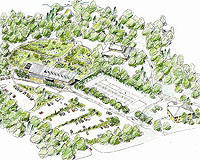 |
for NASA Science News Huntsville AL (NASA) Aug 11, 2009 Engawa is Japanese for "porch," and while that might seem like a strange thing for a space station to have, researchers have been looking forward to the addition for a long time. Space shuttle Endeavour delivered the Japanese-built platform to the ISS on July 22nd and astronauts attached it to Japan's Kibo1 science lab a day later. Now, when a science experiment requires a dose of hard vacuum or radiation, it can be set "out on the porch" for exposure.
And that's just for starters. "Besides resembling a porch, this structure has unique features that differentiate it from the experiment exposure points2 located elsewhere on the station." For instance, the JEF offers temperature control. Like the space station's other external experiment locations, it has a warming plate for thermal control, but unlike the others the JEF includes a cooling feature.3 Another advantage is that JEF experiments can be serviced by Kibo's robotic arm4. "The beauty of this is that payloads can be designed to be 'plug and play,'" says Robinson, "so the robotic arm can install them - no space walk required." On July 24th, Kibo's arm deftly delivered the first two JEF experiments from the Shuttle payload bay to the porch and positioned them5. These Japanese experiments are the SEDA-AP6, short for Space Environment Data Acquisition equipment-Attached Payload, and MAXI7, or the Monitor of All-sky X-ray Image. "SEDA-AP's sensors will measure the space environment of low Earth orbit - neutrons, plasma, heavy ions, high-energy light particles, atomic oxygen, and cosmic dust," explains Robinson. With this experiment, researchers can test the mettle of materials and equipment exposed to the UV light, deep space radiation, and extreme temperatures of space. SEDA-AP will monitor material degradation to help researchers choose the hardiest materials for building future space instruments, equipment, and vehicles. Right: A computer-generated image of Kibo's robotic arm placing the Space Environment Data Acquisition equipment-Attached Payload "out on the porch." [animations] MAXI is an all-sky X-ray scanner with super-sensitive X-ray slit cameras to search continuously for exploding stars, black holes, and other hot cosmic X-ray sources. Earth's atmosphere absorbs X-rays (lucky for us), so astronomers have to send their sensors to orbit. "MAXI will look at more than 1000 different X-ray sources and cover the entire sky," says Tai Nakamura8 of JAXA (Japan Aerospace Exploration Agency). Data from MAXI will be broadcast on the Internet. Upon detecting an X-ray source, MAXI's ground communication system will speed alerts to observers across the globe within 30 seconds. The U.S. has two experiments destined for the JEF this fall: HREP-RAIDS, or the Remote Atmospheric and Ionospheric Detection System, and HREP-HICO, or the Hyperspectral Imager for the Coastal Ocean.9 "RAIDS will tell us about upper layers of Earth's atmosphere called the thermosphere and ionosphere," says Robinson. "These layers are tremendously imortant because that is where many spacecraft and satellites orbit. According to the Naval Research Laboratory, RAIDS is the most comprehensive survey of the thermosphere and ionosphere in 20 years." HICO, also built by Naval Research Laboratory, is a hyperspectral imager for mapping coastal areas.10 That simply means it collects detailed information on the light reflected from these locations. Traditional multispectral sensors, like Landsat, lump the light measured into only a few bands; hyperspectral sensors have hundreds of bands. "Hyperspectral sensors are like Landsat on steroids," says Robinson. "But HICO is a test unit that lacks Landsat's spatial resolution. Similar imagers have flown on aircraft, and another hyperspectral imager is on NASA's Earth Observing-1 satellite as a technology demonstration." "The JEF will help us figure out whether HICO would be feasible for a satellite platform. The 'porch' is perfect for proving imaging technologies in space before investing in sophisticated optics for instruments and putting them on satellites. If HICO passes with flying colors and an operational imager is developed, that new imager could provide unprecedented maps of coastal features." The JEF can host nine different experiments at once and has places for communications equipment, storage, and for berthing Japan's HTV-exposed pallet.11 Many interesting new investigations are planned for the JEF. Stay tuned to Science@NASA for updates from the porch. Share This Article With Planet Earth
Related Links More at NASA Science News Space Technology News - Applications and Research
 Omega seeks 'living building' status
Omega seeks 'living building' statusRhinebeck, N.Y. (UPI) Jul 17, 2009 Owners of an upstate New York human-potential retreat center's new building say it may become the world's first "living building." The $3.5 million Omega Center for Sustainable Living at the Omega Institute for Holistic Studies in Rhinebeck, N.Y., goes way beyond "green," Omega said. The one-story, 6,250-square-foot building, inaugurated Thursday, takes "a whole systems approach" ... read more |
|
| The content herein, unless otherwise known to be public domain, are Copyright 1995-2009 - SpaceDaily. AFP and UPI Wire Stories are copyright Agence France-Presse and United Press International. ESA Portal Reports are copyright European Space Agency. All NASA sourced material is public domain. Additional copyrights may apply in whole or part to other bona fide parties. Advertising does not imply endorsement,agreement or approval of any opinions, statements or information provided by SpaceDaily on any Web page published or hosted by SpaceDaily. Privacy Statement |